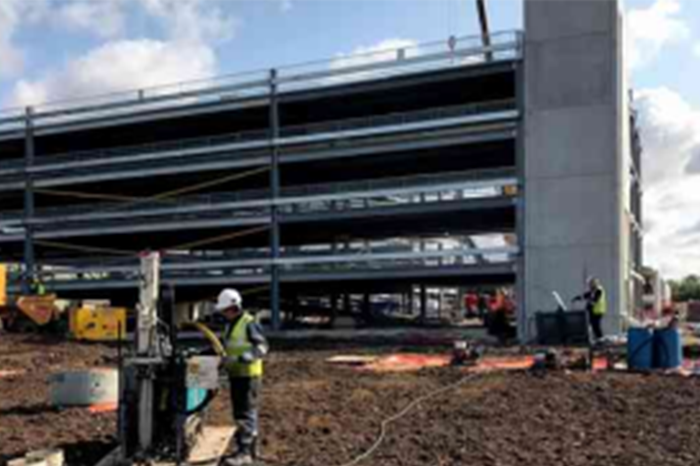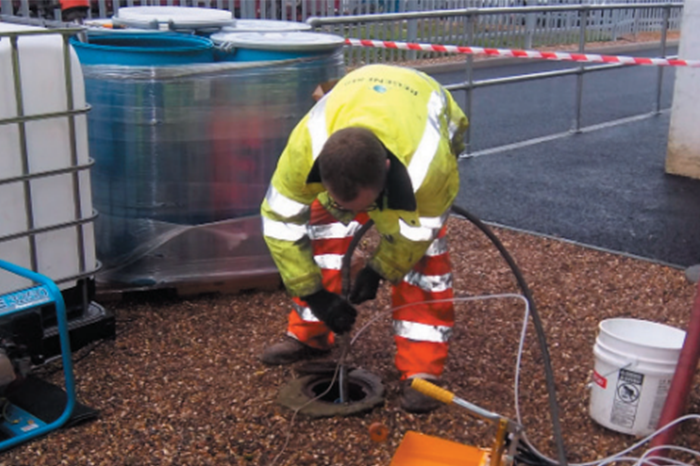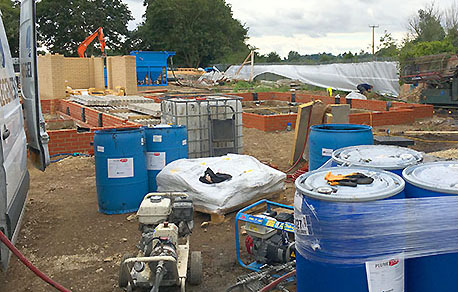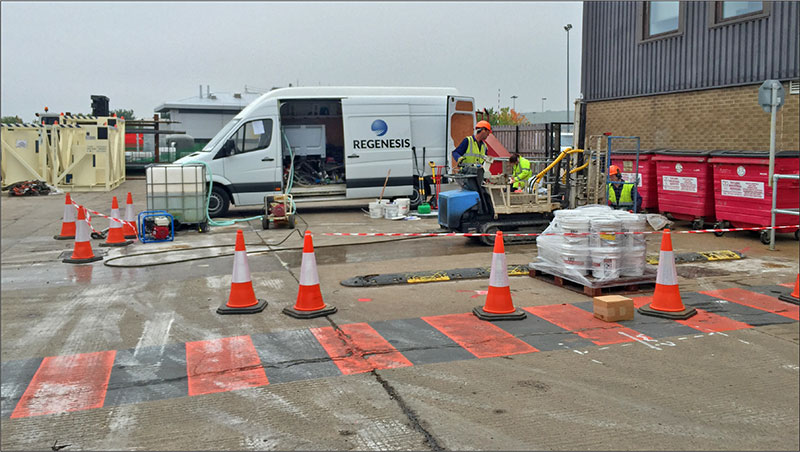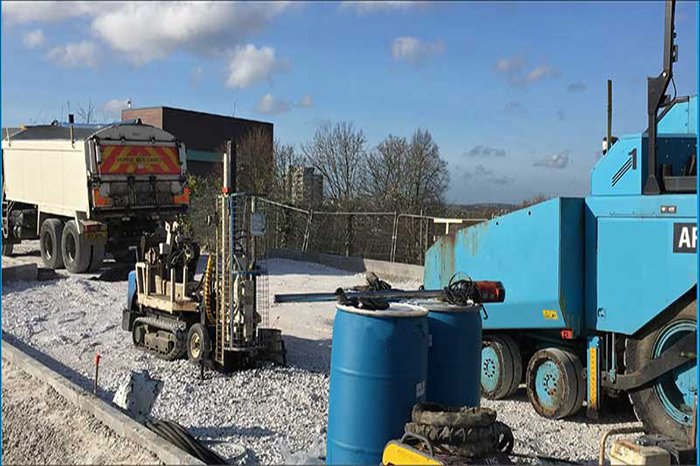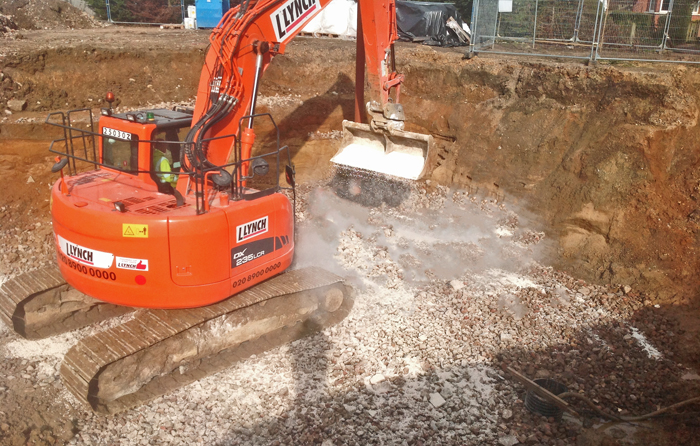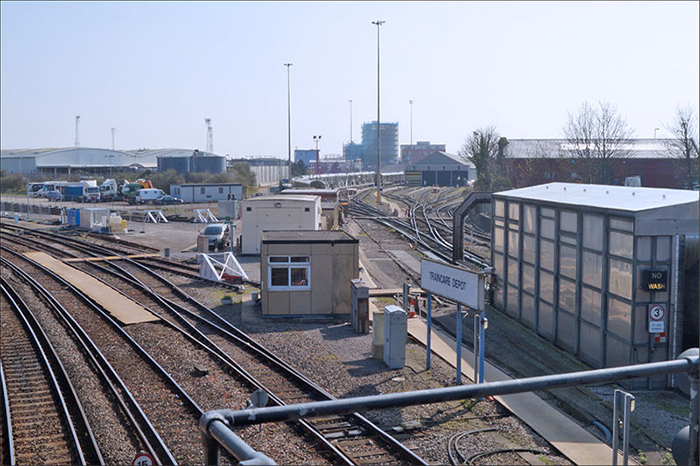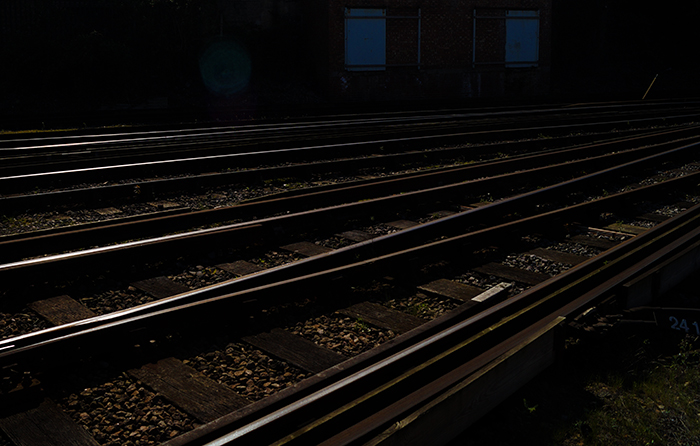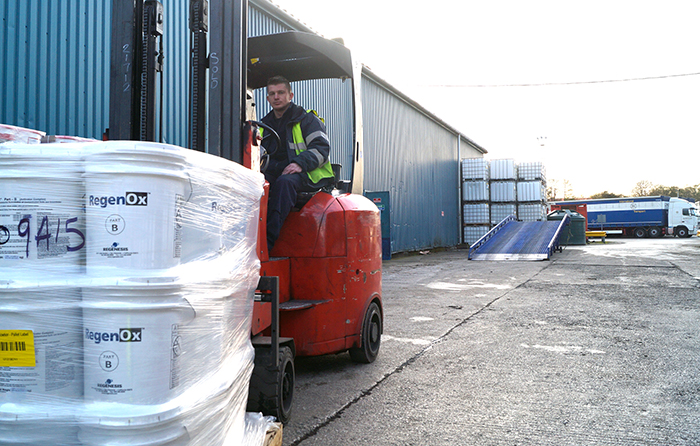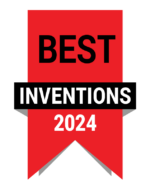Combined approach to remediate chlorinated solvents in Cambridge, UK
In Situ reagent barriers (HRC) treat contaminated groundwater in sandstone under a schoolRead More
Integrated in situ remediation of honing oil in a chalk aquifer, UK
In Situ reagent barriers (HRC) treat contaminated groundwater in sandstone under a schoolRead More
Redevelopment of former gas works unlocked by combining technologies
Integrated remediation strategy provides rapid and cost-effective clean up
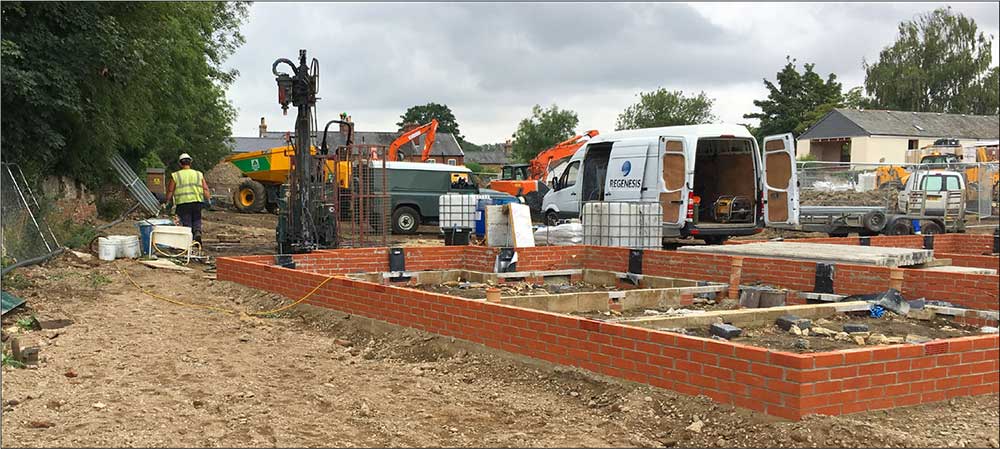
- During the construction of multiple residential dwelling it became apparent that a historical gas works had previously occupied the site.
- A targeted site investigation needed to be completed quickly to identify the areas requiring remedial action, enabling construction to continue in plots outside of the plume.
- A combined remedial strategy was required to address soil, LNAPL, DNAPL and dissolved phase contamination.
- The implementation of the treatment had to be completed around partially completed housing and live underground services.
- The remedial works had to be completed quickly in a manner as to not impact the build program.
- The strategy needed to provide appropriate protection to both human health and controlled waters.
- The need to respond and act quickly required excellent communication and good working relationships to be established between the consultant, stakeholders, regulators and multiple specialist remediation contractors and suppliers.
Remedial Approach
A wide range of remediation technologies were deployed sequentially and in parallel to provide the most rapid and cost effective clean up:
- Ex situ bio-piling of hydrocarbon impacted soils
- LNAPL skimming
- Pump and treat (P&T) of dissolved phase contamination
- DNAPL pumping and settlement/collection
- Enhanced abstraction of contaminant mass using PetroCleanze
- In Situ chemical oxidation (ISCO) using RegenOx, which is compatible with footings and services already in place
- Accelerated aerobic natural attenuation using ORC Advanced slurry
- Accelerated aerobic natural attenuation using a pelletised oxygen-release compound (ORC Advanced) placed in the backfill
- PlumeStop Liquid Activated Carbon injection to install a subsurface activated carbon filter to adsorb and biologically degrade dissolved phase contamination
- Gas vapour membrane installation
Ex situ treatment
The impacted materials within the unsaturated zones within Plume A and B were excavated and placed in a biopile for onsite treatment (Figure 1). Nutrients were added and the biopile was turned until remedial targets were achieved. The soils were then backfilled under the CL:AIRE Code of Practice. Prior to backfill with the remediated soils, ORC Advanced Pellets were added to the base of the excavation. This provided a source of dissolved oxygen for up to a year, stimulating the growth of an effective aerobic biomass and accelerating the degradation of the petroleum hydrocarbon contamination.

In Situ Treatment
The southern part of Plume A was made inaccessible by footings and services; here in-situ treatment was completed accommodate these obstructions without compromising treatment efficacy. Within Plume B, where high levels of contamination had been encountered (Figure 2), several in situ remedial actions were taken as appropriate to concentration, location and sequence in the strategy:
- REGENESIS injected PlumeStop, a micron-scale colloidal Liquid Activated Carbon substrate along the western margin of the site via direct push to protect the offsite surface water. PlumeStop creates a subsurface activated carbon filter which adsorbs the contaminant influx, which is then degraded by the microbial growth on the carbon biomatrix. Biological degradation was also accelerated through co-application of ORC Advanced and the presence of the pelletised ORC placed in the base of the excavation upgradient, providing a controlled release of oxygen.
- Where LNAPL and high dissolved phase concentrations were observed, a network of injection boreholes were installed by Rake Remediation/REGENESIS. Many of the wells were installed by removing suspended floors and lifting in a mini-rig to complete the drilling beneath partially constructed dwellings. Through these wells, multiple applications of RegenOx were completed. This in situ chemical oxidant was chosen as it was safe to handle on this busy site and would not corrode services installed at the site, nor would it be detrimental to the concrete footings.
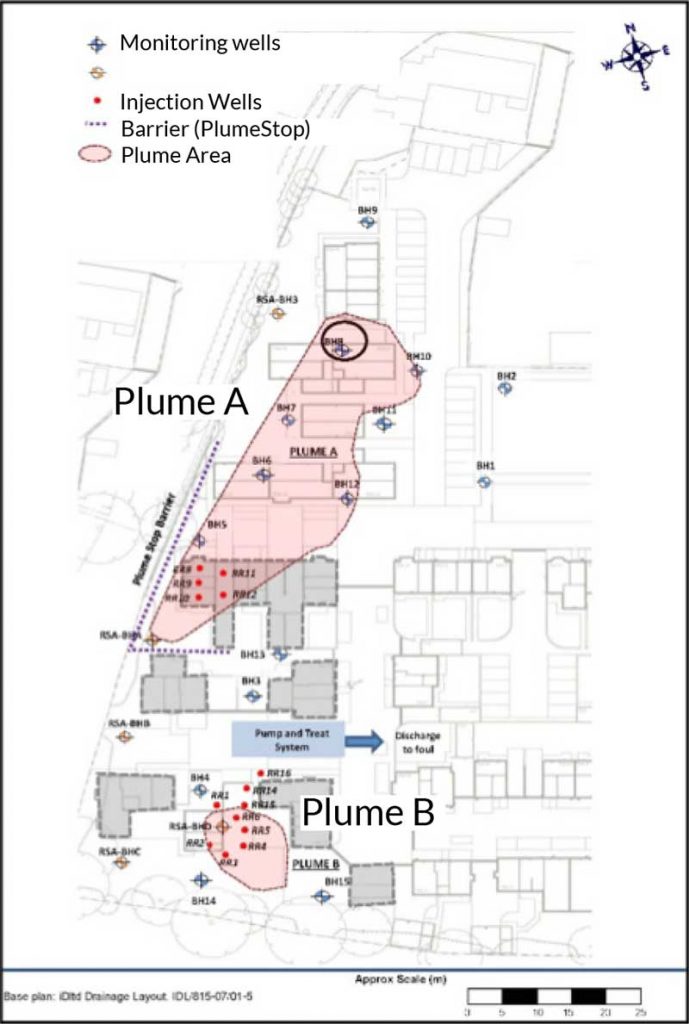

- Following the ISCO, ORC Advanced slurry was injected to enhance the natural attenuation (ENA) of the residual dissolved phase contamination to low levels.
- In Plume B, high levels of contamination in the form of both L- and DNAPL were encountered. This was removed using a P&T system augmented with PetroCleanze, an inorganic surfactant that uses a high pH, carbonates, silicates and partial oxidation to remove contaminants from soils. The PetroCleanze was injected to produce a temporary desorption event, which once observed, allowed the P&T system to be switched back for a short period to remove the contamination. This process was repeated three times to maximise the efficacy of the P&T and shorten the treatment programme.
- Once the NAPL was removed, multiple rounds of RegenOx were completed, followed by ORC Advanced via injection through wells.
- Long term groundwater monitoring programme was put in place to monitor the effectiveness of the clean-up.
Results
The following graphs (Figures 7 and 8) show the variations in concentrations for selected priority contaminants of concern over the monitoring period for Plume A and B. These show a marked reduction in the hydrocarbon dissolved phase concentrations over time, with compliance achieved with the remedial criteria.
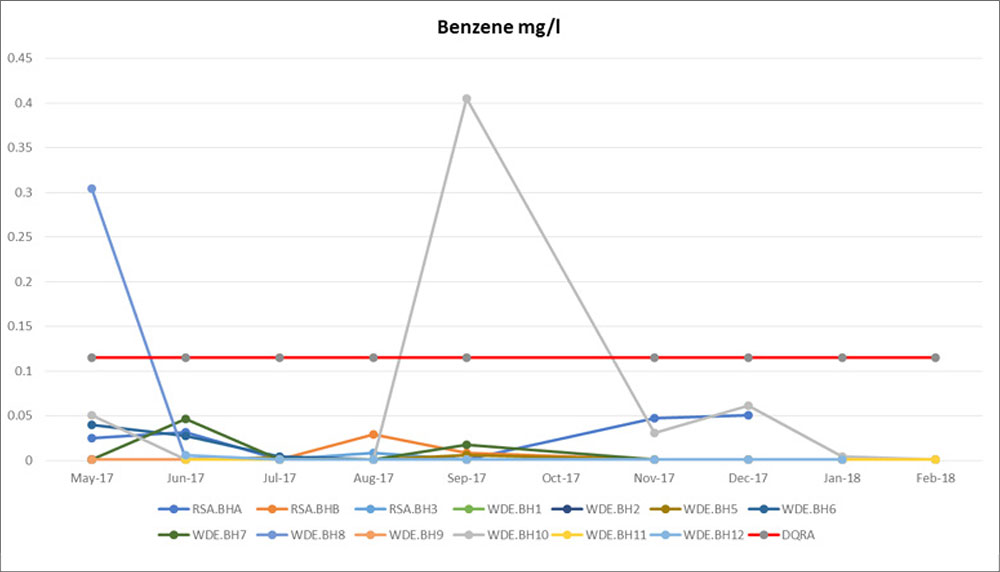

Conclusion
Complimentary remedial technologies were combined successfully to achieve:
- Contaminant mass reduction to below remedial targets in the soil and groundwater within 6 months.
- Protection of onsite and offsite receptors.
- Written confirmation by the Environment Agency that they ‘agree with (the reports’) conclusions’ and that ‘development may proceed’.
- Remediation completed on a tight budget – as remediation had not been foreseen by the developer.
- Ex-Situ remediation of soils and their reuse on site under the CL:AIRE CoP avoided offsite disposal of ~800m3 to landfill.
- In Situ enhancement of the P&T system, minimising the time, cost and volume of abstraction required.
- By combining the technologies intelligently, both simultaneously and sequentially, the programme length was minimised – allowing construction to continue within only 6 months.
Treatment of mixed chlorinated ethenes and ethanes at an active site, UK
Introduction
REGENESIS was approached to offer an in situ remedial solution to address high levels of mixed chlorinated solvent (TCA and TCE) contamination of the groundwater at a site in northeast Scotland. At the time, an ongoing DPVE system was operating, but was unable to achieve the remediation goal of a 75% reduction in chlorinated solvent mass. Furthermore, a supplementary MIP investigation showed that there was more contamination at depth (>6m) which the DVPE system was not able to reach.
Download pdf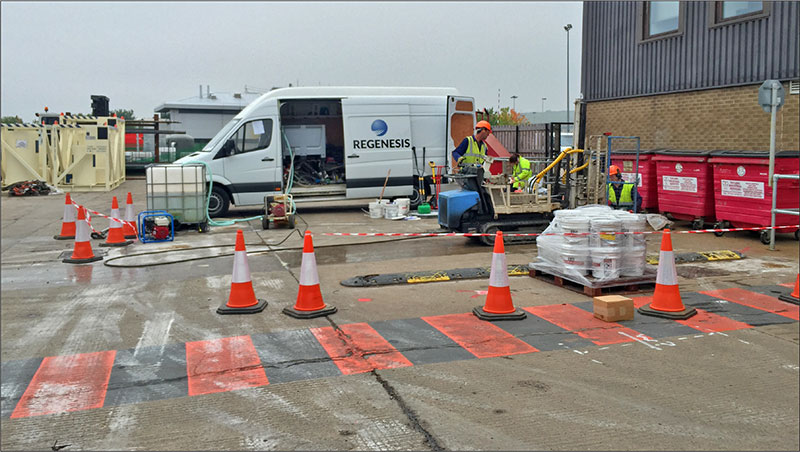 Fig. 1 REGENESIS Remediation Services applying 3DMe and BDI Plus on site
Fig. 1 REGENESIS Remediation Services applying 3DMe and BDI Plus on site
The initial design was based on treatment between 3 – 9m BGL of the aquifer across a 1,200m2 using 3DME and BDI with the preferred method of application being direct push injection. However, during the MIP investigation progression of the rods deeper than 6mBGL was found to be difficult. This raised concerns that (1) direct push injection would not be able to reach 9m BGL and (2) injection of the required dose of 3DMe may not be possible. REGENESIS were therefore asked to undertake a pilot study over a limited area to demonstrate that the works were possible. This was completed successfully and also showed excellent dose response and demonstrated to the site owners that the works (which were completed at night) would not have a deleterious effect on their operations.
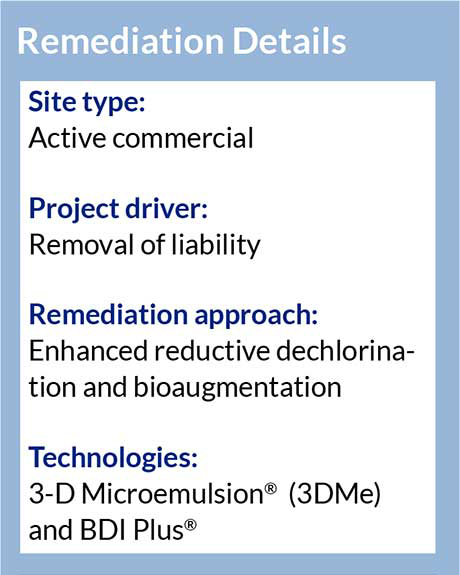
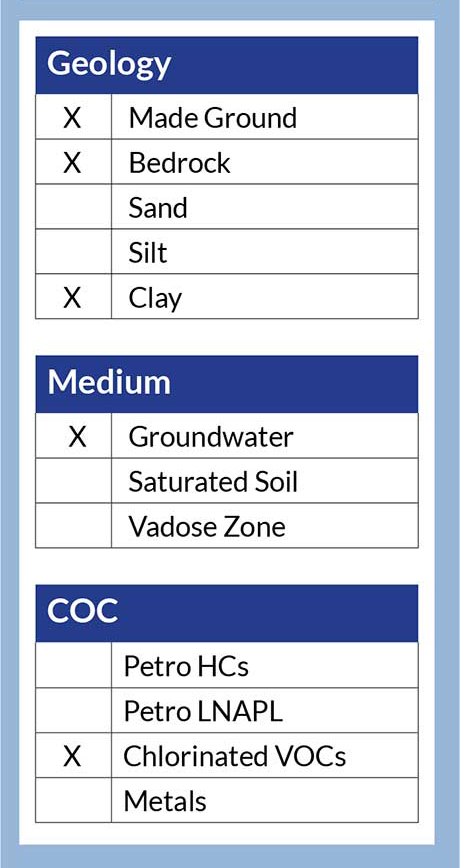
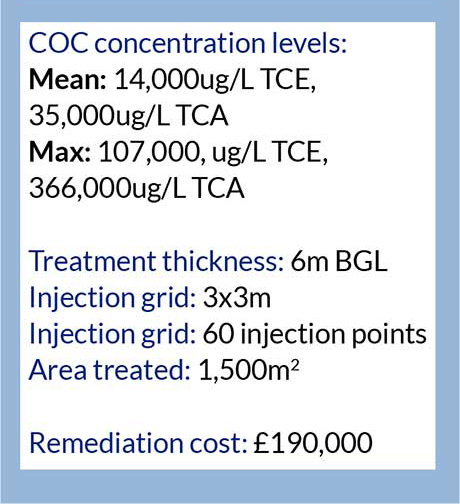
Full Scale Application
The pilot trial was conducted over two days (see figure 1) during which the direct push injection rig had no problems getting the injection rod to the required depth of 9m BGL (unlike the MIP). Furthermore, the required volume of 3DMe was accepted by the aquifer with minimal daylighting/surfacing.
Following the MIP and pilot, the fullscale design was tailored to provide the most cost effective approach for the site. 60 direct push injection points were completed over 10 nights, with no disturbance to the site operations.
The direct push injection points were centred on BH 11, a pre-existing well, to ensure we had good baseline data. Both BH11 and the surrounding wells were monitored over 8 months to assess the effect and distribution of 3DMe.
Results
Following the injection works, quarterly validation monitoring was completed. Post injection monitoring showed no inhibition of parent compound degradation due to the mixed halogenated compound plume. 98% and 99% reduction in mean concentration of TCA and TCE respectively.
Full reductive dechlorination was achieved with no build up in daughter products (see fig 2 and 3). The validation curves suggest that both biotic and abiotic degradation occurred.
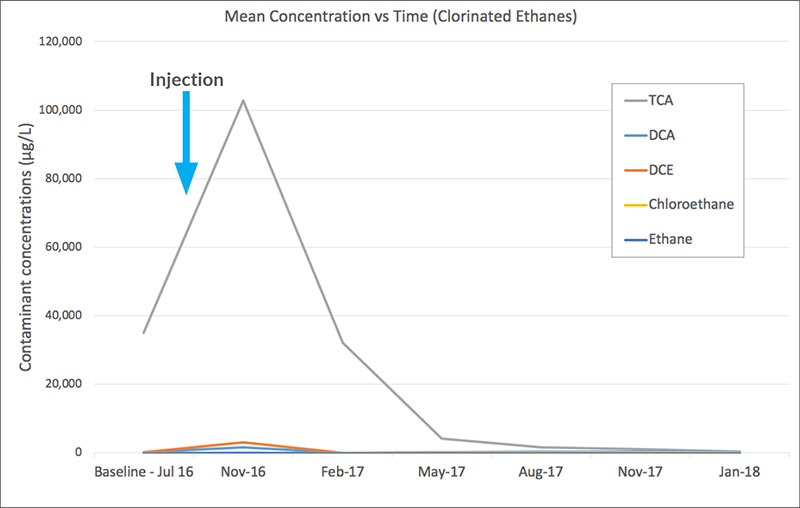
Fig. 2 Mean concentrations of Chlorinated Ethanes over time
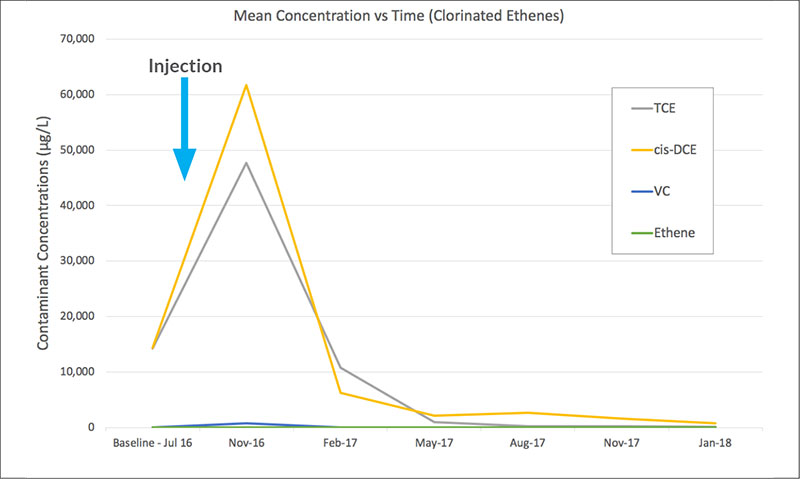
Fig. 3 Mean concentrations of Chlorinated Ethenes over time
Abiotic degradation occurred through the production of reduced iron species by the production of low redox conditions created by the 3DMe.
What’s Special
- A limited pilot study was used to prove the practicality and efficacy of the proposed approach. This area did not require further injection, so added little extra cost to the remediation of the site.
- Bioaugmentation using BDI+ avoided any inhibition of either chlorinated ethenes and ethanes by ensuring that the microbial consortia contained viable counts of dehalogenating bacteria specialising in either contaminant group.
- Very high levels of contamination, suggestive of DNAPL, were reduced to very low concentrations within 18 months.
- No build up of degradation products occurred, showing full reductive dechlorination was achieved and sustained.
- No disturbance of the onsite operations occurred during the limited injection time onsite, with the remediation occurring under the site as it continued to function normally.
- Remediation goals were achieved.
Fig. 4 REGENESIS’s team onsite

Galligu and TPH Contaminated Site Remediation in Runcorn, UK
Summary
Wildgoose Construction’s redevelopment of a former bus depot into commercial/retail, including a new public house for Marston’s, posed unique and complex challenges. Geotechnical and Environmental Associates Ltd (GEA) identified that each step in the solution process would have a follow-on effect, so a well thought-out, integrated approach was crucial for the project’s success.

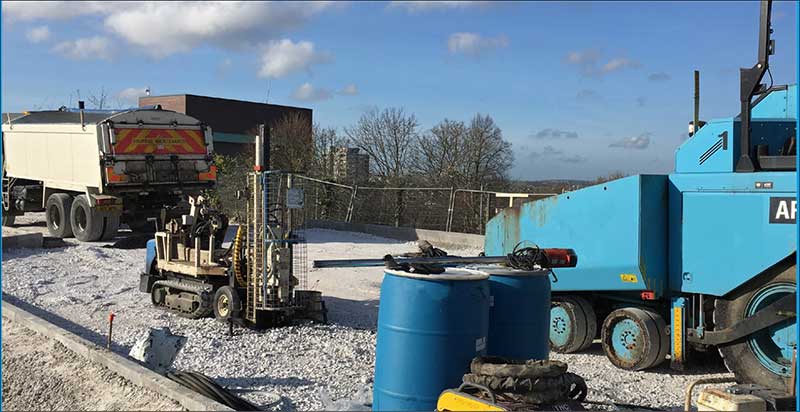
Fig. 1 – PlumeStop barrier injection near site boundary
The site comprised a hillside covered by industrial waste from the Leblanc process comprising several metres of galligu above a black ash layer which was underlain by cohesive glacial till. Two geoenvironmental issues needed addressing:
- Stability: the galligu had a weak structure, with a ‘toothpaste’ consistency in parts;
- TPH contamination; leaking underground storage tanks (UST)s onsite resulted in fuel infiltrating the subsurface and moving offsite via perched water in an ash layer beneath the galligu. The downgradient boundary comprises a steep slope to the canal where the contaminated groundwater egressed at ground-level, polluting the waterway.

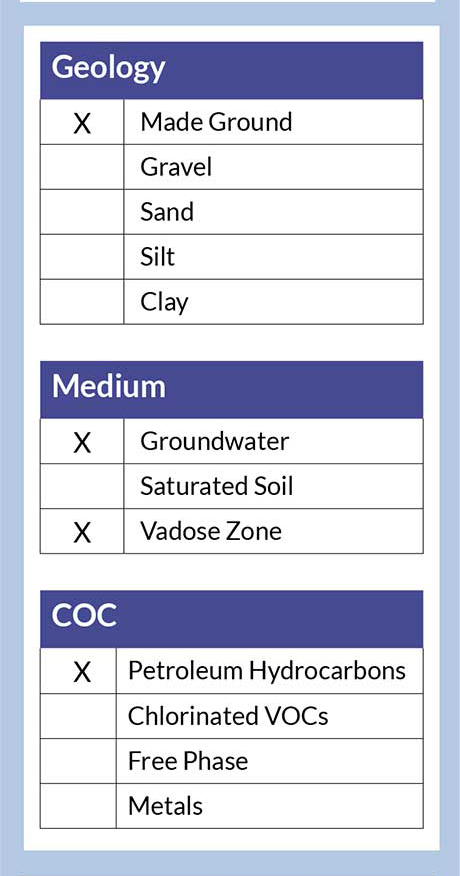
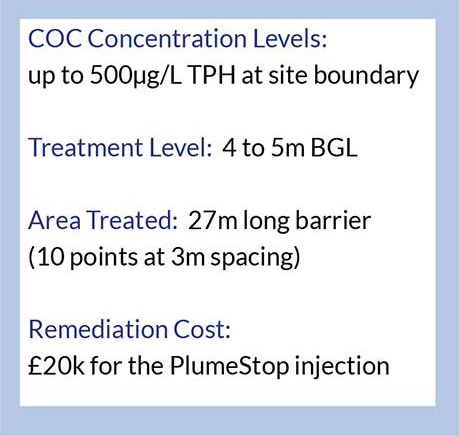
An integrated solution: Soil/cement mixed panels were used to support structures, with a soil/cement mixed mattress covering the entire site, as a load transfer platform. Installation of these panels altered the groundwater flow, which therefore needed modelling to ensure the contaminant treatment could be targeted accurately.
Modelling groundwater flow through anthropogenic waste and man-made installations presented a challenge, as models are designed for more homogeneous and isotropic conditions. However, it was shown that groundwater would be raised and channelled towards the panel ‘wall’ at the boundary. Here the groundwater would funnel through gaps at a higher velocity.
An innovative Liquid Activated Carbon substrate was used to integrate with the panels, which required no maintenance and provided effective treatment in the extremely bio-toxic environment created by galligu. This subsurface carbon-filter entirely prevented contaminant egress from the site.
Integrated Geoenvironmental Solution
The structure of galligu varied across the site: from fused crystalline ‘rock’ in upper areas, to a weak ‘toothpaste’ consistency at depth – unsuitable to build on. Previous settlement caused hydrocarbon leaks from broken pipes, resulting in the bus depot closure. Potential settlement prevented the use of a raft foundations. In addition, the presence of a high pressure gas main prevented the use of a piling solution. Therefore a soil/cement panel solution was piloted and then installed full scale by Deep Soil Mixing Ltd, using in situ mixing equipment (see figure 5 and 6).
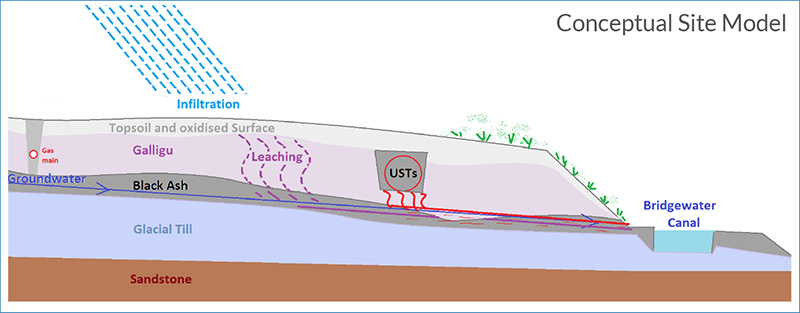
Fig. 2 – Conceptual Site Model in Section

Fig. 3 – Remedial Strategy in Section
The geotechnical solution created a new challenge: to understand how the cement stabilised columns would alter the groundwater flow pattern across the site. This was crucial to know, in order to determine where contaminant egress may occur at the site boundary.
Galligu creates strongly alklaline, arsenic rich, reduced conditions in the subsurface. This inhibits biological degradation, resulting in ongoing persistence of TPH. This chemistry prevents typical remedial approaches to be taken as the remedial solution would have to: not react with the cement, galligu or ash; capture the hydrocarbons in the toxic conditions produced by the galligu; work for decades, until the residual secondary source is depleted, without power, pumping or further action.
When PlumeStop Liquid Activated Carbon (LAC) was chosen, the placement of this underground filter needed to be carefully considered. At the boundary, the groundwater flow was extremely fast through the gaps. Hence, by moving the barrier into the site, the slower groundwater allowed for a longer treatment time in the PlumeStop. The PlumeStop barrier length was guided by the modelling, to transect the entire contaminant plume. REGENESIS provided bespoke design work to match the predicted groundwater flow and contaminant levels (i.e. the contaminant flux).

Application
REGENESIS worked with GEA and their client to ensure the design matched their requirements. REGENESIS also managed and completed the injection works onsite using direct push injection, and then provided a completion report and warranty.
All work was completed on a busy construction site, with a high-pressure gas main and large easement.

Results
Following injection of the PlumeStop across the width of the predicted contaminant plume, the TPH concentrations at the site boundary were dramatically reduced by 98%. Although not the main focus of the treatment, low levels of PAH were also reduced to non-detect.

Fig. 14 – TPH concentrations at site boundary before and after PlumeStop barrier treatment
Conclusion
This integrated geoenvironmental solution was highly successful, delivering a number of key achievements:
- Galligu is often treated ex-situ, which was not practical in this situation. The soil/cement stabilisation approach provided an economical solution to the geotechnical problems presented by Galligu, whilst encapsulating the contaminants within it and minimising future leaching. Being a low disturbance technique, it also permitted treatment alongside a high-pressure gas main where piling was not permitted. Groundwater modelling of the altered flow pattern was required to allow the design of the remedial scheme. Due to the inevitable uncertainties associated with groundwater flow through the ash layer this modelling was carried out using a low cost electrical analogue modelling technique.
- The remedial scheme allowed the project to proceed within budget and was delivered on time.
- Treatment of petroleum hydrocarbon contamination in the presence of galligu has not been completed previously to our knowledge.
- This was the fourth use of PlumeStop in the UK and represents an imaginative and fully thought-through application that allowed highly effective remediation, protection of a public waterway and cost-effective geoenvironmental treatment of a busy and difficult site.
This project has won in the category ‘Best Conceptual Design’ in the Brownfield Briefing Awards 2018, and was shortlisted in the GE Awards 2018.
Integrated Remediation of a Petrol Filling Station, Middlesex, UK
Integrated remediation of a former petrol station using enhanced pump and treat, excavation application and barrier injection.Read More
Rapid, Effective Remediation of Free Product at an Active Rail Depot, UK
Augmented Pump and Treat, In Situ Chemical Oxidation (ISCO) and Enhanced Natural Attenuation (ENA) completed under rail lines by REGENESIS Remediation Services. Read More
In Situ Remediation of Petroleum Hydrocarbons at Rail Depot, Bristol, UK
Surface petroleum hydrocarbon contamination had resulted from historic and on-going leaks at a train maintenance depot near Bristol, where trains were stabled overnight. REGENESIS was asked to design a remedial approach for a hotspot treatment of this contamination within one of the rail tracks.ORC Advanced Socks were installed in wells for the treatment of the dissolved phase contaminants in groundwater. The quick application showed the ease of installation, with only validation of the groundwater required to provide evidence of treatment. The ORC Advanced provided a >90% reduction in the groundwater within the hotspot area.
Remediation of a Diesel Plume at an Active Rail Facility in Yorkshire, UK
Enhanced Natural Attenuation of a TPH Plume using ORC Advanced as part of an integrated treatment train solution provided by AECOM.Read More
Remediation of Chlorinated Hydrocarbons at Manufacturing Facility, UK
AECOM successfully applied a phased treatment train solution for chlorinated solvents under an operational manufacturing facility. After an initial Dual Phase Extraction (DPE) phase, REGENESIS and AECOM devised a remedial design based on the updated Conceptual Site Model including In Situ Chemical Oxidation (ISCO) using RegenOx®, and Enhanced Reductive Dechlorination (ERD) using HRC®, to treat the residual contamination in groundwater.
Read More

 Americas
Americas Europe
Europe Français
Français Deutsch
Deutsch Italiano
Italiano Español
Español